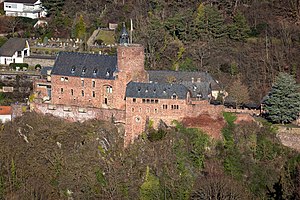Hengebach Castle
| Hengebach Castle | ||
|---|---|---|
|
Hengebach Castle seen from the south |
||
| Alternative name (s): | Heimbach Castle | |
| Creation time : | before 1348 | |
| Castle type : | Hilltop castle | |
| Conservation status: | Received or received substantial parts | |
| Construction: | Quarry stone | |
| Place: | Heimbach | |
| Geographical location | 50 ° 38 '0 " N , 6 ° 28' 46" E | |
| Height: | 216 m above sea level NN | |
|
|
||
The Hengebach castle stands in Heimbach (Eifel) , a town in the northern Eifel , above the Rur in Düren , North Rhine-Westphalia .
The hilltop castle is on a 216 m above sea level rising freely from the Rur valley . NN high ridge built oval ring castle from the 12th to 14th centuries. The core of the system is the western courtyard of the 12th-13th century with the dungeon / Palas combination. The eastern part of the castle complex belongs to the expansion of the 14th century. This includes the forecourt of the castle, the garden and the kennel . The residential buildings erected on the south side above the Rurtal, which are also set up for defense purposes, also originate from this construction phase.
history
middle Ages
Godizo von Aspel-Heimbach was the first verifiable owner of the castle. In 1011 he bequeathed it to Count Gerhard von Metz (Mosalensis). He was the governor of Godizo's daughters Irmingardis and Ermintrudis. However, through the marriage of the widow Godizos, Gerhard von Monterberg came into possession of the castle. Thereupon Gerhard from Lorraine and his ally Balderich von Drenthe besieged the castle in order to wrest it from Gerhard von Monterberg. He was killed in an ambush and the castle men surrendered. From 1016 to 1021, the castle was the seat of Count Balderich, who was expelled from his own property in 1016, who undertook raids from there and died there in 1021.
Ermintrudis, Godizo's daughter, got Hengebach Castle. She was married to Bruno Graf in Zulpichgau and guardian of the royal estate in Flatten. After Bruno (son of Richwin I von Ripuarien, Graf im Eifel 992-1033, Wildban Kempenich 992, Herr zu Heerlen) Hengebach went to his brother Richwin II., From him to his son Godfried, who in turn made them around 1075 and 1094 Son Ethelger (Adelger) von Zülpich handed over, a great-grandson of Godizo, referred to in documents as Herr von Hengebach. Thereafter, at the beginning of the 12th century, Hermann I von Hengebach is mentioned, a son of Adelger. He was the first owner of the castle, who belonged to the von Hengebach family, and was probably the progenitor of the Hoen von Heimbach line to Loevenich Castle. The line ended with the death of Everhard III. around 1237. The Jülich and Heimbach territories were united under the rule of Count Wilhelm IV of Jülich .
Until the occupation of the Left Bank of the Rhine by French revolutionary troops and the associated practical dissolution of the Duchy of Jülich towards the end of the 18th century, Hengebach Castle was continuously owned by the Counts and later Dukes of Jülich, after the death of the last Duke Johann Wilhelm in 1609 Heirs to fall to the Count Palatinate of Pfalz-Neuburg.
The castle fell into disrepair. A fire in 1687 made Heimbach Castle completely in ruins.
Modern times
With the annexation of the Left Bank of the Rhine to France , the castle became the property of the French state, which sold it in 1804 to the Fraikin family from Heimbach. This used the ruin as a quarry. Because of the danger of collapse, they gave up the castle in 1904. It was decided to completely level the facility to the ground.
At this critical point in time, citizens of Düren founded the “Association for the Preservation of the Heimbach Castle Ruins” based in Düren . The association acquired the castle and initiated extensive security measures. In 1935 the Schleiden district , to which the town of Heimbach belonged at the time, bought the castle. The plan was to completely restore the complex and turn it into a local museum . When the essential planning work had already been completed, the Second World War wrecked everything again.
Since the Schleiden district did not have the means to rebuild the ruins after the war, the castle was leased to a Düsseldorf brewery on a long-term basis in 1952, but with the condition that the facility be restored. The brewery partially restored the castle by 1954 and operated a restaurant and hotel there. In 1969 the Schleiden district terminated the lease and in 1970 began the complete reconstruction of the castle.
After the municipal reorganization in 1972, the Düren district continued work as the new owner. Today the town of Heimbach is the owner of the castle, which was used as a restaurant and hotel again after the restoration and the extremely controversial connection of the old building fabric with modern elements. After renovation, the Heimbach International Art Academy opened its doors on August 23, 2009 .
literature
- Christian Quix : The Counts of Hengebach. The castles and towns of Heimbach and Niedeggen . The former monasteries Marienwald and Bürvenich and the Collegiatstift later Minoriten monastery before Niedeggen; represented historically. Hensen (ed.); Aachen 1839 ( E-Kopiw ).
Web links
- History of Heimbach and its castle
- Entry by Hans-Jürgen Greggersen zu Heimbach in the scientific database " EBIDAT " of the European Castle Institute
- The history of Heimbach (PDF file; 1.96 MB)
- Homepage of the art academy
- Reconstruction drawing by Wolfgang Braun


